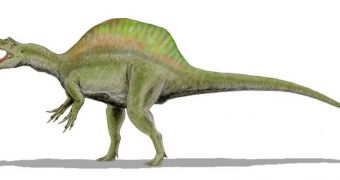Many years after the initial fossils were discovered, paleontologists finally managed to learn that the spinosaur was a giant lizard that really loved water. In fact, it loved it so much that it spent most of its life living and hunting in shallow streams or along shorelines. This in turn allowed it to remain relatively safe from the most renowned predator of the day, the Tyrannosaurus Rex. In a recent study, it was determined that the two creatures might have coexisted after investigators analyzed the signature of oxygen isotopes found in the fish-feeding spinosaur, Nature News reports.
The new discovery also paints an image of an ancient world in which not all dinosaurs remained on land. Naturally, as the experts behind the report say, we are not talking about marine creatures, but about land-based animals that were very fond of water. Some of these dinosaurs, which a number of experts exclude from the dinosaurian lineage, became highly adapted to survive in this mixed environment over time. They developed piercing teeth, for example, unlike most other predators that featured serrated teeth. This was a very specific adaptation to eating fish, the researchers say.
The work was conducted by Romain Amiot, who is a geologist at the University of Lyon, in France. Details of his team's investigation were also published in the latest issue of the respected scientific journal Geology. The experts also give the examples of Plesiosaurus and Ichthyosaurus, as animals that looked like dinosaurs, which were also not a part of the lineage. They add that the ancient world, before the Cretaceous-Tertiary extinction event, may have been populated by a variety of creatures wider than first imagined.
Scientists found that the spinosaur was fish-eating when they discovered a fossil of a species called Baryonyx walkeri that was a part of this group. The team investigating the remnants at the time discovered partially digested fish scales inside the stomach of the giant lizard, and established that it must have been highly reliant on fish for its survival. This particular skeleton was discovered in England, in 1983. However, the scientists also found that B. walkeri in itself was not an aquatic animal per se, in the sense that it did not feature fins, webbing, a propelling tail, or any other indicator that it might have evolved in the waters.

 14 DAY TRIAL //
14 DAY TRIAL //